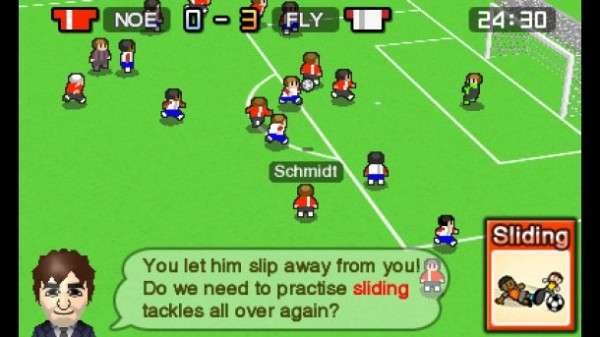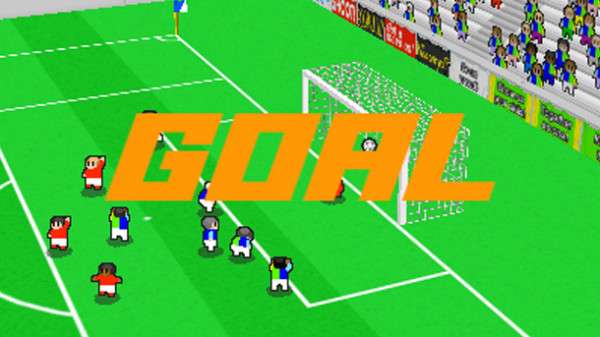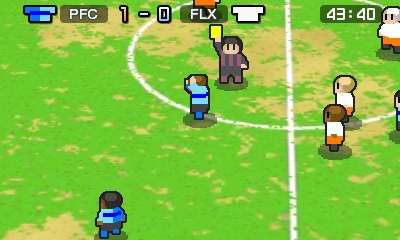
Nintendo Pocket Football Club 3DS Review
Nintendo has brought us plenty of various sports games in the past, but they normally incorporate Nintendo’s huge range of franchise stars to bring more attention to the game. I find Nintendo Pocket Football Club to be a surprising release from the house that created Mario since the chubby plumber is nowhere to be found, and the only link to having a relationship to Nintendo is from the game’s name and that your Mii is represented as the team’s manager.
While this is a first time Nintendo has released a football management game in the West, Japan has actually had one before on the GBA called Calcio Bit, which is in fact the ancestor to Pocket Football Club. The game arrived too late in the life of the GBA to be included for translation into English, but now this remake, a game that was in development for six years, is on the Nintendo eShop for download at £10.79 until 1st May 2014, then £13.49 after. This is Nintendo experiment a title in Europe again, since this is the land of football (explains why there is no American release date yet), and they might just have managed to capture a potential market, the people who do not like the complexity of typical football management games, but would like to play a more easier to understand management game, one that’s more “gamey” than simulation.

Coming from a title like Football Manager 2014, even if you only play its Classic Mode, is still incredibly more complex than anything going on in Pocket Football Club. While Sega’s popular management simulator lets you take part in everything to do with managing a football club, with a real licence to back that up, Pocket Football Club streamlines this to a basic system, one that anyone can get into without much dedication or tutorials, but also one that seems to have been developed with some strange design choices that kind of work in its favour of this simplicity approach, along with its made up fantasy teams and players.
I speak of things like being unable to change any tactics until half-time or during substitution; making these changes to the squad during a match feel more impactful than screaming at your captain to get the team into strategic positions. In fact, tactics are quite minimal, with options of a concentration zone for your players to keep focused in, three types of tactics (attack, neutral or defend) and the ability to highlight a key player to watch. So what exactly can you do when it comes to managing your team? Well you can set up custom formations, moving players around specific grids on the formation plan to get them in the positions you prefer, but that’s all you’re getting. This is because the core gameplay behind Pocket Football Club is built around a system of training cards, injecting a sort of luck-based training system to improve your squad. You can also buy players as well, but this is hard to do in the beginning when the club lacks funds, so the focus is on training your squad with these cards and seeing them grow into their full potential. I didn’t even buy a player till my second season, and that was due to a couple of injuries on my star midfielders.

As a new manager for a team that you create by giving them team colours for home and away kits, along with a logo and a name, you have to take over a group of inexperienced players who need your attention to improve. Of course, improvements are done through careful training regimens with these special cards I mentioned. Training cards are rewarded from taking part in matches, 45 minute training matches or friendlies, and are the most important feature of Pocket Football Club that give your team a shot at promotion in each of the game’s four leagues, all the way to eventually completing the game’s task, which is to get to Pro League 1 and do the treble of winning the league, cup and European competition. This is no easy task, and will take seasons to accomplish over the game’s weekly-based scheduling (not daily, like Football Manager).
Training cards come in one of four colours, which represent the categories of Tactical, Technical, Physical and Support. It’s random what cards are awarded during matches, so I often found playing 45 minute training games just to gain more cards while not tiring out my team too much. If players begin to tire out, their icon will alter from green to yellow, or even red if close to exhausting, which can result in injury if played during a match. It’s important to make sure the team stays fit, because it can really make a dint in your armour when you have to swap a star player with one you haven’t quite looked after as well.

Each player can be giving a combination of up to three cards every week. The idea behind the training cards is to give players cards that build up a stat based around their position. A defender will benefit from toughness increase, while a striker will becoming better at shooting if you raise their kicking stat. It’s clear what card will raise which stat, as the player’s profile highlights this, but you won’t know exactly how many it will offer until you use it. It’s good to keep a memory of which cards offer the biggest boosts, so you can keep reusing them to improve a player faster.
Certain combinations of cards unlock special training buffs, which increases stats even more. The Wild Man combo, which requires Running, Aerobics and Sprinting, give a huge increase to speed and stamina, while Set Plays, Running and Karaoke translates to Goalie Runs Up, offering kicking and stamina to the goalie, but also unlocking the ability for the goalie to become Peter Schmeichel and run up to the other team’s penalty box during last minute corners to try head in a goal. Once a hidden combination is discovered, they will remain in a list, so you can revert back to seeing which ones you have discovered. It’s a shame that it only highlights if you have the cards to do the combination again, as you cannot simply click on that hidden training combo to begin the training. You must pick the two or three cards yourself each time, and with over a 100 different combinations, it’s hard to always remember the exact card combination every time.

The effects of training can turn players into various skilful roles. Everyone on the team begins as a balanced type, but stat increases will turn them into focused players, such as a forward becoming a Chancer, meaning he’s the Van Nistelrooy of the team, waiting for that goal poaching opportunity to knock your team in front. Midfielders seem to gain skills more focused on mixing plays, passes and skills, like the Maverick type, who spends time flashing off his tricks before passing on the ball. For defence, Marker and Stopper are a mixture to keep out any attackers. These types aren’t permanent, if you begin changing their stats around players can revert back to Balanced or switch to another type, letting you change your best team members through training, rather than switching between weaker benched players.
Changes to a player’s style can be seen during the matches, and while Pocket Club Football looks ripped straight out of the colourful 16-bit era, the style is charming and the matches can be entertaining to watch, more so as the players get better and begin to play like real football players, rather than hooligans who just boot the ball up the pitch. I do find it exceptionally weird that you cannot increase the match speed, meaning that every time you play a match you have to sit through the entire thing, which can last around eight to ten minutes. This became annoying later on, when I just wanted to progress through the season after I knew I wasn’t able to gain promotion to the next league, but that option isn’t there, and not being able to skip or speed up matches can make the progress feel artificially extended for no real reason, especially for a handheld game, where people are opening and closing their 3DS after a match or three on a bus or train journey.

Streetpass and online are a feature of Pocket Football Club, and are built into the game seamlessly, requiring no time from the other player. This is because these modes are done through an AI manager that takes your team, along with the AI command slider settings to make sure he manages similar to how you would (although it doesn’t always work well). There is no control over substitutes or match strategies – this is all left to the AI – so you’re left watching the match unfold on your screen and waiting for the outcome. Results are then sent back to the online server, adjust your position in the league accordingly to the results. The more time you put into creating the best team offline will certainly help you when you begin to try take over the online players. There isn’t much else to do online, so this mode feels more like a side-quest, a less important part than the single player, but still good fun to jump into every now and then to see how your team pits against others in Europe.
There are charming aspects of Nintendo Pocket Football Club to like – it looks cute, makes it easy for newcomers to get into, features simple strategy options that keep the difficulty curve down, and it can be addictive, as I found out when I kept playing the game in sessions that would completely drain a full battery charge. But among the charm and trading card-esque nature of the title, there are some features and design choices that leave behind a simple “Why?” This is a series that has potential to grow and get better with each sequel, but right now, as Nintendo Pocket Football Club stands, it’s a lovely bite size entry into football management that makes the genre feel more like a charming game with personality, rather than a set of overcomplicated calculations and stats.
